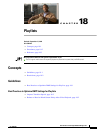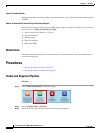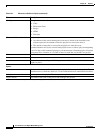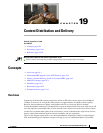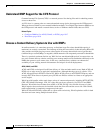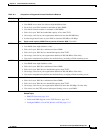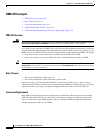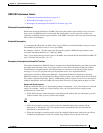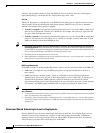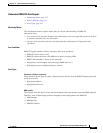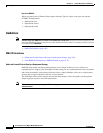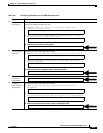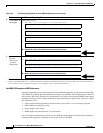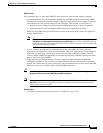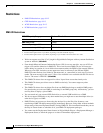
19-5
User Guide for Cisco Digital Media Manager 5.4.x
OL-15762-05
Chapter 19 Content Distribution and Delivery
Concepts
DMS-CD Performance Factors
•
Differential Download Intelligence, page 19-5
•
Bandwidth Consumption, page 19-5
•
Resumption of Interrupted and Paused File Transfers, page 19-5
Differential Download Intelligence
Differential download intelligence in DMS-CD prevents the needless provisioning of any asset more
than once to any DMP that uses it and already has downloaded it, even if you have used the asset
repeatedly in multiple playlists or presentations. Your DMPs retain their valid assets and download only
what is new or has changed.
Bandwidth Consumption
A systemwide threshold that you define limits in your WAN how much bandwidth is used per session
when DMS-CD provisions assets to one of your DMPs.
For example, a limit of 1.2 mbits means that file transfer speeds for DMS-CD deployments cannot
exceed the maximum threshold of 1.2 mbits per DMP.
Thus, if your deployment provisions assets to 20 DMPs, the maximum WAN bandwidth that DMS-CD
uses is 24 mbits, because 20 x 1.2 = 24.
Resumption of Interrupted and Paused File Transfers
File transfer resumption in DMS-CD helps to compensate for bandwidth throttling and other constraints
that might limit how many assets you can provision at a time. Such constraints commonly include a
limited number of nighttime hours when deployments are certain not to disrupt the digital signage
messages or Cisco Cast programs that your organization shows to its targeted audiences.
Values that you define at Deployment Manager > Deployment Preferences determine in part how
DMS-CD responds to any incomplete file transfers, but its response also considers the size of individual
files within a deployment package. Finally, a DMP might generate a queue for itself if it is the target of
multiple deployments, because a DMP can receive data from only one deployment package at a time.
Outages and Other Disruptions
When the scheduled delivery of a deployment package is interrupted—by a power failure or a network
outage, for example—while you are provisioning assets, the file transfer process might resume
automatically at a later time.
•
When sufficient time remains during the same deployment window that was interrupted, your file
transfer resumes after your retry interval has elapsed.
Tip You set this interval in the “Deployment retry time (in seconds)” field.
•
When the interruption extends past the end of the scheduled deployment window and the
deployment is scheduled to recur, file transfer resumes automatically the next time that the
deployment is scheduled to run.
•
When the interruption extends past the end of the scheduled deployment window but you did not
schedule the deployment to recur, file transfer stops without success and does not recur.



